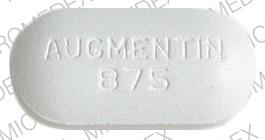Augmentin Disease Interactions
There are 7 disease interactions with Augmentin (amoxicillin / clavulanate).
Amoxicillin-clavulanate (applies to Augmentin) hepatotoxicity
Major Potential Hazard, Moderate plausibility. Applicable conditions: Liver Disease
The administration of amoxicillin-clavulanate has infrequently been associated with hepatotoxicity such as elevations in serum transaminases, bilirubin, and/or alkaline phosphatase. The histologic findings on liver biopsy have consisted of predominantly cholestatic and/or hepatocellular changes. Symptoms may occur during or several weeks after therapy. The hepatotoxicity is generally reversible, although deaths have been reported on rare occasions, mostly in patients with serious underlying diseases or concomitant use of other medications. Liver enzyme abnormalities have also been observed with the use of amoxicillin or ampicillin alone. According to the manufacturer, therapy with amoxicillin-clavulanate should be administered cautiously in patients with evidence of hepatic dysfunction. Periodic monitoring of liver function is recommended during prolonged therapy. The use of amoxicillin-clavulanate is contraindicated in patients with a history of cholestatic jaundice or hepatic dysfunction associated with the drug.
Antibiotics (applies to Augmentin) colitis
Major Potential Hazard, Moderate plausibility. Applicable conditions: Colitis/Enteritis (Noninfectious)
Clostridioides difficile-associated diarrhea (CDAD), formerly pseudomembranous colitis, has been reported with almost all antibacterial drugs and may range from mild diarrhea to fatal colitis. The most common culprits include clindamycin and lincomycin. Antibacterial therapy alters the normal flora of the colon, leading to overgrowth of C difficile, whose toxins A and B contribute to CDAD development. Morbidity and mortality are increased with hypertoxin-producing strains of C difficile; these infections can be resistant to antimicrobial therapy and may require colectomy. CDAD must be considered in all patients who present with diarrhea after antibacterial use. Since CDAD has been reported to occur more than 2 months after antibacterial use, careful medical history is necessary. Therapy with broad-spectrum antibacterials and other agents with significant antibacterial activity should be administered cautiously in patients with history of gastrointestinal disease, particularly colitis; pseudomembranous colitis (generally characterized by severe, persistent diarrhea and severe abdominal cramps, and sometimes associated with the passage of blood and mucus), if it occurs, may be more severe in these patients and may be associated with flares in underlying disease activity. Antibacterial drugs not directed against C difficile may need to be stopped if CDAD is suspected or confirmed. Appropriate fluid and electrolyte management, protein supplementation, antibacterial treatment of C difficile, and surgical evaluation should be started as clinically indicated.
Aminopenicillins (applies to Augmentin) mononucleosis
Moderate Potential Hazard, Moderate plausibility.
Patients with mononucleosis treated with an aminopenicillin antibiotic, may develop a pruritic erythematous maculopapular skin rash. The rash is usually self-limiting and resolves within days of discontinuing the offending agent. An altered drug metabolism or an immune-mediated process unrelated to drug hypersensitivity has been proposed as the underlying mechanism. Therapy with aminopenicillin antibiotics should not be administered in patients with mononucleosis.
Amoxicillin (applies to Augmentin) diabetes
Moderate Potential Hazard, Moderate plausibility. Applicable conditions: Diabetes Mellitus
High urine concentrations of ampicillin may result in false-positive reactions when testing for the presence of glucose in urine using Clinitest®, Benedict's Solution or Fehling's Solution. Since this effect may also occur with amoxicillin, it is recommended that glucose tests based on enzymatic glucose oxidase reactions (such as Clinistix®) be used.
Amoxicillin (applies to Augmentin) PKU
Moderate Potential Hazard, Moderate plausibility. Applicable conditions: Phenylketonuria
Some amoxicillin chewable tablets and suspensions products contain phenylalanine. The phenylalanine content should be considered when these products are used in patients who must restrict their intake of phenylalanine (i.e. phenylketonurics).
Beta-lactams (oral) (applies to Augmentin) renal dysfunction
Moderate Potential Hazard, High plausibility.
Most beta-lactam antibiotics are eliminated by the kidney as unchanged drug and, in some cases, also as metabolites. The serum concentrations of beta-lactam antibiotics and their metabolites may be increased and the half-lives prolonged in patients with impaired renal function. Dosage adjustments may be necessary and modifications should be based on the degree of renal impairment as well as severity of infection in accordance with the individual product package labeling. Renal function tests should be performed periodically during prolonged and/or high-dose therapy, since nephrotoxicity and alterations in renal function have occasionally been associated with the use of these drugs.
Penicillins (applies to Augmentin) hemodialysis
Moderate Potential Hazard, High plausibility.
Penicillin antibiotics (except for agents in the penicillinase-resistant class) are removed by hemodialysis. Doses should either be scheduled for administration after dialysis or supplemental doses be given after dialysis.
Switch to professional interaction data
Augmentin drug interactions
There are 90 drug interactions with Augmentin (amoxicillin / clavulanate).
More about Augmentin (amoxicillin / clavulanate)
- Augmentin consumer information
- Check interactions
- Compare alternatives
- Pricing & coupons
- Reviews (447)
- Drug images
- Side effects
- Dosage information
- Patient tips
- During pregnancy
- Support group
- Drug class: penicillins/beta-lactamase inhibitors
- En español
Related treatment guides
Drug Interaction Classification
| Highly clinically significant. Avoid combinations; the risk of the interaction outweighs the benefit. | |
| Moderately clinically significant. Usually avoid combinations; use it only under special circumstances. | |
| Minimally clinically significant. Minimize risk; assess risk and consider an alternative drug, take steps to circumvent the interaction risk and/or institute a monitoring plan. | |
| No interaction information available. |
Further information
Always consult your healthcare provider to ensure the information displayed on this page applies to your personal circumstances.


